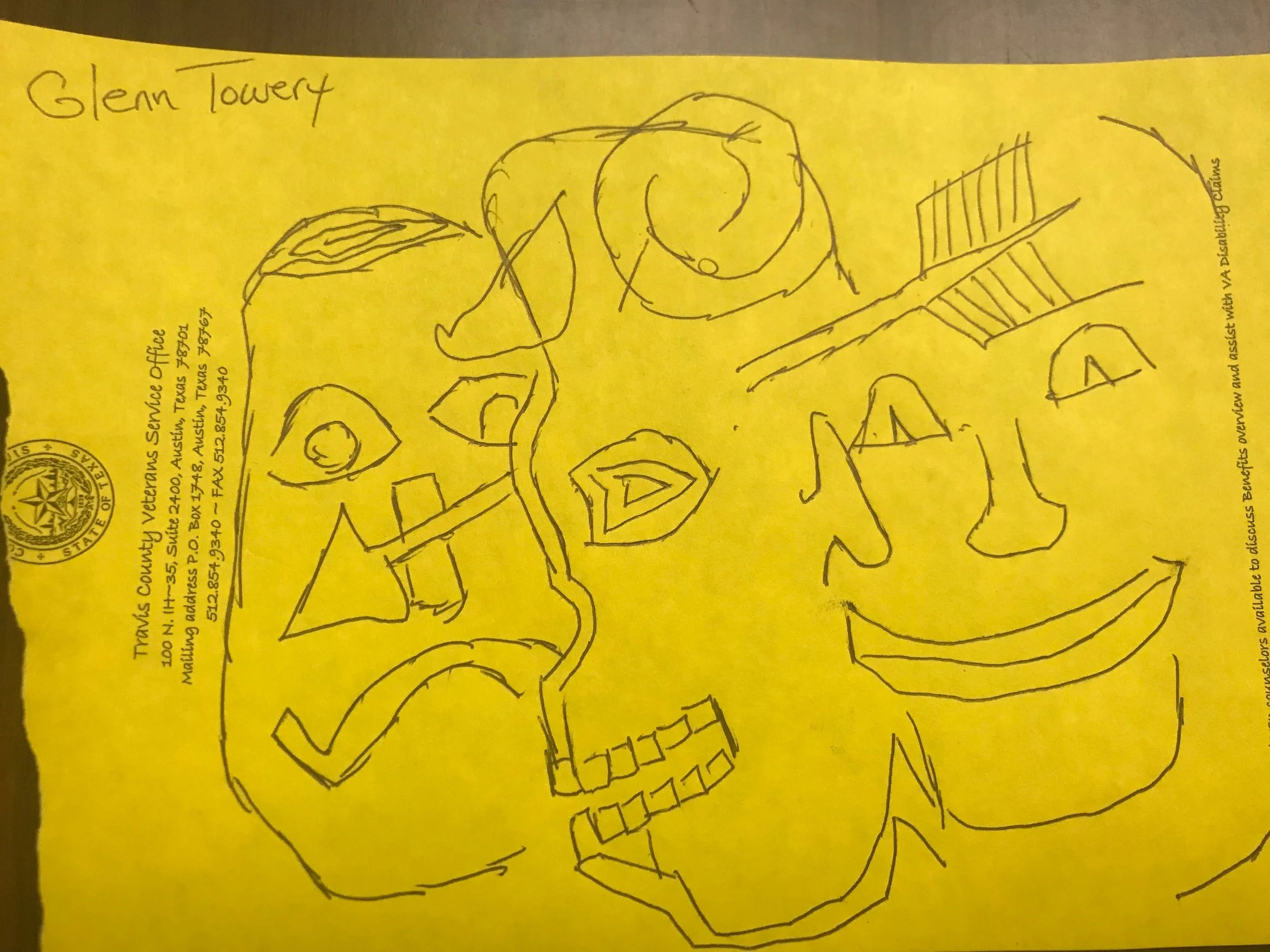Week of July 16
With readings from the past weeks fresh on their minds and hearts, the group begins practicing the creative process. While reminiscent of grade school assignments, “Art Day” begins the important step of actualizing creative thought and textual interpretations. The group is encouraged to use one moment from their readings to illustrate with the supplies Bart has brought to class. The illustrations can be directly from the stories, or inspired by them in ways that tie in their personal experience. After 15 minutes of drawing, the works are shared (some reluctantly) and discussed among the group.
James:
Class description: Planes overhead of what looks like a school with students under the desks. The American flag atop the school makes it clear that the planes attacking the school are not American. A quote is displayed at the bottom saying: “I hear the Gods calling me to my death.”
Intended Meaning: James goes into detail about his life-long history with the atomic bomb. He clarifies that the image represents his school aged experience with the Cuban Missile Crisis at age 7. The striking quote represents the mortality he had to face at such a young age.
Meagan:
Class description: A soldier in war standing while mom and/or wife trying to lure him back from battle. They eventually decipher that the soldier is Hector from the Iliad.
Meaning: Meagan intended to represent how Hector’s heart is connected to his troops in battle, more so than his family. This relates to her own complicated experience of being deployed over and over again. While a soldier’s heart is obviously connected to the family back home, there is a connection in the figurative or literal battlefield that civilian family members will not often understand.
Terry:
Class description: They see battleships and a cityscape colored blue and pink. Long and short arrows point in both directions. Perhaps a stalemate or standoff situation between the two sides. They also debate whether or not they are on the same side of the battle since both the blue and pink are represented on both sides.
Meaning: “We are you, you are us.” Equality is the general sentiment that Terry wants to illustrate with this image. His inspiration came from the last page of the Iliad book 24 which closes with “all sides being even.”
Darrin:
Class description: A winged goddess holds what looks like a torch. She’s perhaps signaling during or before a battle. Sees freedom, but also travesty and deception because of the gods’ tendencies.
Meaning: Darrin was inspired by the statues that line the UT campus where this class discussion is held. The Statue of Victory to him, represents Athena. The group accurately guessed that the drawing is Athena before going into her deceit of Hector.
Gianna:
Gianna's drawing is immediately recognized as a soldier memorial. They note that the landscape does not have the same detail as the boots, gun, and tags. Since this ceremony only happens overseas, or for the soldiers and wife and kids, perhaps this is taking place during a deployment. They discuss how social media has popularized an image that would commonly only be known to those affected by deployment and war.
Meaning: Gianna confirms the soldier memorial ceremony theory and clarifies that the desolate background is a desert, specifically Iraq. She was inspired by the description of the funeral site in the Iliad.
Mike:
Class description: Two soldiers seem cornered and one is angry. A quote from the Iliad is above their heads reading, “when a young man is killed in war, even though his body is slashed with bronze, he lies there in beautiful death.” The quote overhead reminds them of barbed wire and hesco barriers.
Meaning: With his image, Mike intends to turn the notion of the “Beautiful Death” mentioned in the texts on its head - or in his words, “fuck all that.” Using his tablet he draws a depiction of his first mission as a medevac pilot, which still haunts him. The image depicts two remaining soldiers as they watch their deceased comrade being airlifted away. He excuses his lack of art skills, but still captures the anger and frustration from the two servicemen.
Glenn:
Inspired by his recent reading of AJAX, Glenn attempts to depict the loss of sanity Ajax experiences after the trauma of war. The middle figure represents death, while the two outside figures present a balance of conscience.
The next step in the creative process this week is revisiting past works from group members. James, a playwright and veteran shares his one act play The Joy of Mechanical Force.
Inspired by a true story from a funeral home in Odessa, Texas, the play is humorous, dark, and reminiscent of themes discussed in the texts. The group enjoys the readings and the pop culture references thoughtfully placed throughout. Gianna related to the play through her background in funeral work in and outside of the military. There are several motifs in the play that stand out to the rest of the group - death, self-righteousness, Greek names, and uncomfortable emotions.
A short Q&A with James on his creative process follows. Questioning the overall human motivation for war vs. peace, Brian wonders how to encompass these broad themes in a way that is understood by civilians. James describes his process as highly conceptual and personal; he doesn’t create until there are emotions attached. Brian counters that he actually wants to do the opposite and explore things that can be easily translated to everyone.
Following a productive week of dipping their toes in the “creative waters,” the group is told to make a collage, or mood board of possible concepts for their final project.






